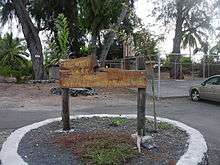Milolii, Hawaii

Miloli'i is an unincorporated community on the island of Hawaii in the U.S. state of Hawaii, 33 miles south of Kailua-Kona.[1] The village is situated at the seacoast where the 1926 lava flow from Mauna Loa entered the ocean.
Miloli'i is purported to be "the last Hawaiian fishing village" according to a wooden sign in their community center.[2] Without access to power lines or water, each house provides its own electricity and water with solar panels and tanks that collect rain water.
On February 5, 1868 a tsunami carried a church, named Hau'oli Kamana'o and swept it away to Miloli'i. Surprisingly, the church remained in good condition and still stands in Miloli'i today.
One little bit of celebrity came to Miloli'i in 1962 when the village was selected for background scenery in the Elvis Presley movie "Girls! Girls! Girls!" A Hollywood film crew spent several weeks in Miloli'i, with one house in the village used as the home of the Elvis character in the film. Ultimately, only a tiny bit of the Miloli'i footage actually appeared in the movie, offering just a fleeting glimpse (a few seconds on screen) of the village beach early in the film.
The songbird of Miloli'i resident, Diana Aki, became a successful singer of Hawaiian music. In the late 1970s she recorded a few records, was featured in a documentary and she also performed in dinner shows at various resort hotels in Hawaii, primarily Kailua-Kona.
The unofficial Mayor is Uncle Willy Kaupiko.
Miloli'i was also the focus of a UCLA anthropological research project in the mid-1970s. The research was led by UCLA professors Robert Edgerton and Douglas Price-Williams, and several graduate students conducted studies along the Kona coast, including Miloli'i and Ho'okena. Francis Noel Newton's doctoral dissertation Aloha and Hostility in a Hawaiian-American Community: The Private Reality of a Public Image[3] is a study of village life in Miloli'i.
References
- ↑ "Milolii, Hawaii". Geographic Names Information System. United States Geological Survey.
- ↑ Gorry, Conner and Julies Jares. Hawai'i: The Big Island. Oakland: Lonely Planet Publications, 2002.
- ↑ Newton, Francis Noel (1978). Aloha and Hostility in a Hawaiian-American Community: The Private Reality of a Public Image. Dissertation. University of California, Los Angeles. 353 pages. ProQuest Publication Number 7820267.
Coordinates: 19°11′10″N 155°54′26″W / 19.18611°N 155.90722°W
